Have you ever wondered, does Montana see the Northern Lights? With its sprawling landscapes and minimal light pollution, it offers some of the most breathtaking views of the Aurora Borealis in the United States.
From the rugged cliffs of Glacier National Park to the serene waters of Whitefish Lake, the state’s natural wonders provide a spectacular stage for the Northern Lights’ mesmerizing performance. I’ve had the privilege of experiencing many of Montana’s prime Northern Lights viewing spots firsthand.
In this article, I’ll guide you through the top locations where the night sky comes alive with ethereal hues of green and purple. You’ll discover secluded lakes, panoramic mountain vistas, and even a rustic saloon where the Aurora Borealis might just be the night’s special guest.
- Related article: Montana Travel Advice
So, are you ready to embark on a journey through the heart of the Rockies, to places where the night sky is alive with color? Let’s dive into the best places to view the Northern Lights in Montana, and prepare to be captivated by the celestial ballet that awaits.
7 Key Takeaways on Montana Northern Lights
- Montana is an excellent destination for Northern Lights viewing, with Glacier National Park being a top location due to its dark skies and minimal light pollution.
- To increase the chances of witnessing the Northern Lights in Montana, it’s essential to head north away from city lights. The state’s vast stretches of undeveloped land and naturally dark skies provide the perfect backdrop for this celestial phenomenon.
- The Northern Lights can be seen in Montana, particularly from locations like Cascade County and Seeley-Swan Valley, from September to March. The ideal time for sightings is around an hour before and after midnight, with clear skies being a crucial factor.
- Montana offers a mix of solitude and social settings for Northern Lights viewing. Glacier National Park provides secluded spots as well as the Northern Lights Saloon & Café for a communal experience.
- Lakes such as Lake McDonald in Glacier National Park and Whitefish Lake State Park are praised for their reflective surfaces, which enhance the Northern Lights viewing experience by mirroring the dazzling colors in the water.
- Montana also offers a variety of activities, from hiking and water sports to exploring historical museums and enjoying local festivals. These activities enrich the overall experience of visiting the state.
- Some locations provide unique experiences, such as the Sleeping Giant near Helena, where the elevation and wilderness setting create a private viewing atmosphere, and Bozeman, which combines the convenience of a town with good viewing conditions due to minimal bright lights.
Montana Northern Lights: Where Can You View Them?
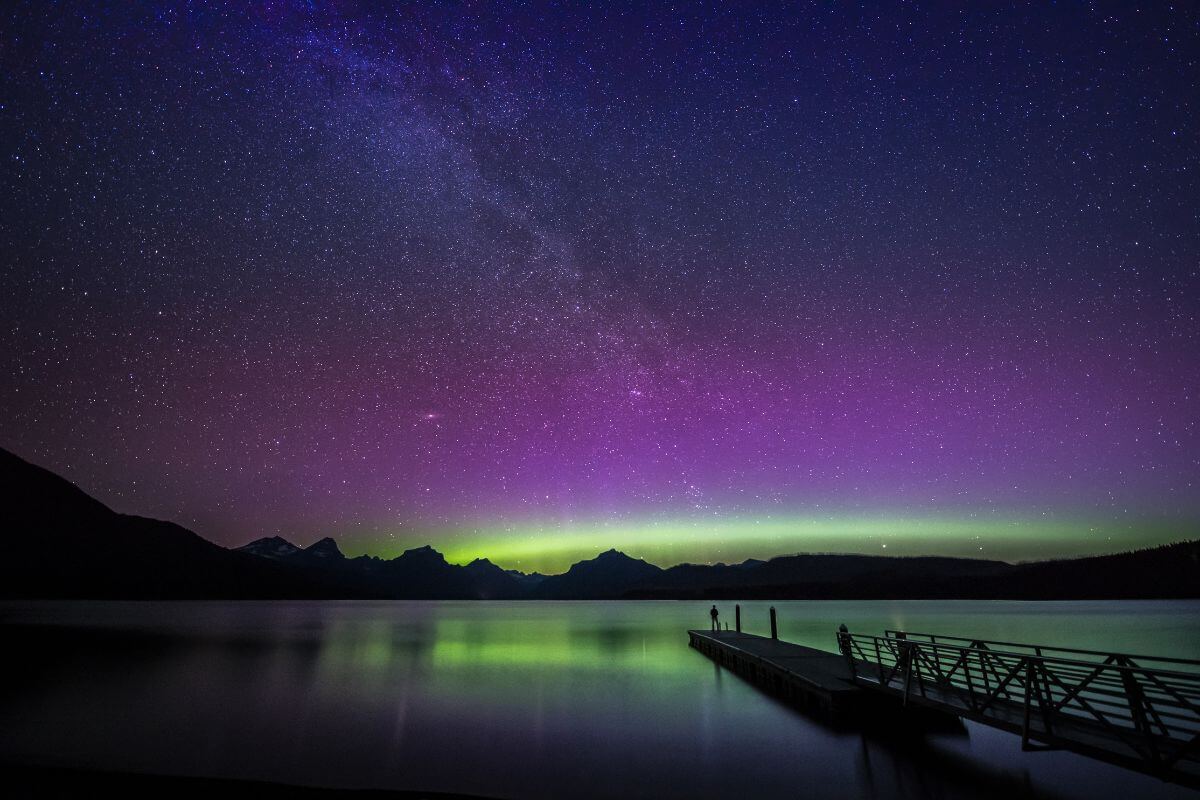
I can’t help but be mesmerized by the mysterious dance of the Northern Lights, also known as polar lights, created by electrically charged particles colliding with the Earth’s magnetic field. It’s a phenomenon that should be worth the travel time to reach Montana any day.
If you share my fascination and are searching for the best places to witness this awe-inspiring spectacle in the United States, then escaping the bright city lights and heading north to Montana might just be the perfect move for you.
One of the prime spots for viewing the Northern Lights in Montana is Glacier National Park, boasting dark skies and minimal light pollution that enhance the chances of catching a glimpse of this celestial marvel.
The state’s vast areas of undeveloped public lands, small cities, and dark skies provide the ideal conditions for observing this natural phenomenon.
In the northwest of Montana, numerous secluded areas have gained recognition as some of the prime spots where fortunate observers can witness the captivating green lights of the Northern Lights.
Northern Lights in Montana: 12 Best Places to See Them
When it comes to witnessing the ethereal dance of the Northern Lights, Montana offers a front-row seat in the heart of nature’s theater.
From the rugged peaks of Glacier National Park to the serene shores of Flathead Lake, the Big Sky State is a prime destination for catching this celestial spectacle. Here are 12 locations we recommend you visit for an unforgettable Northern Lights experience in Montana.
1. Glacier National Park
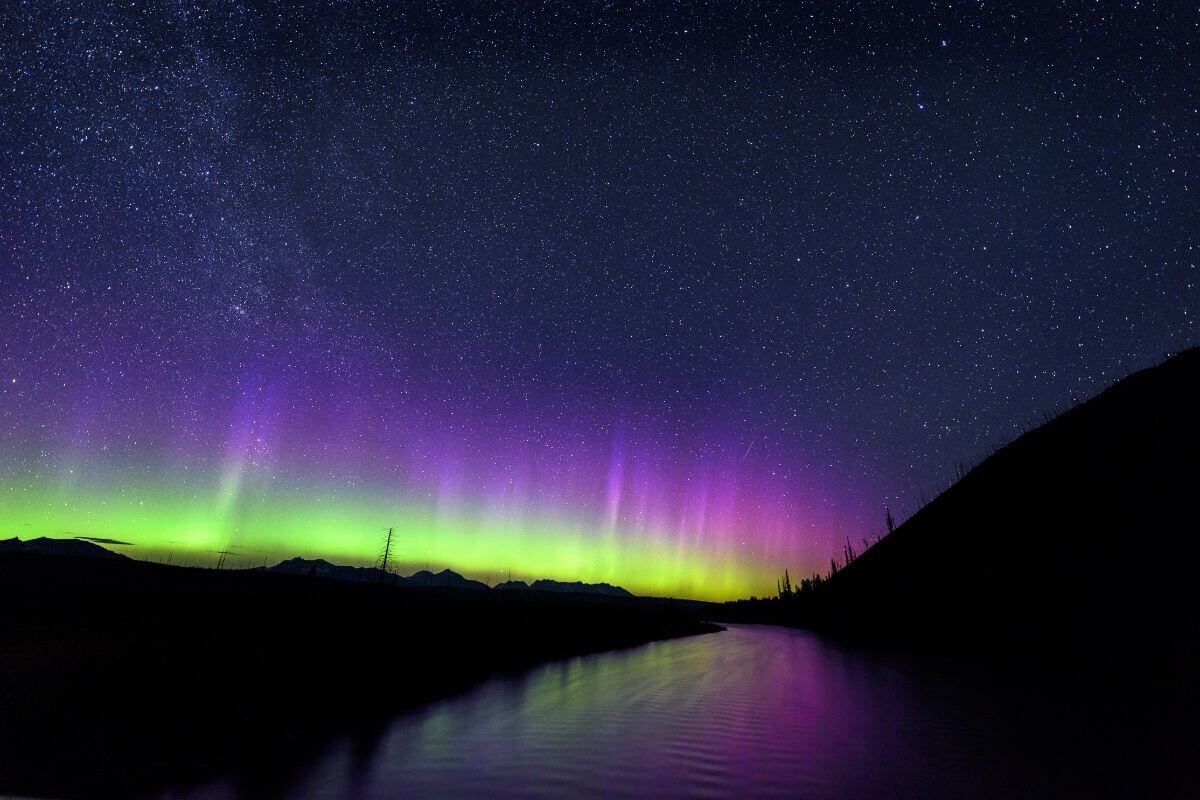
Glacier National Park isn’t just about jaw-dropping mountain vistas and pristine alpine lakes — it’s also a prime spot for catching the ethereal dance of the Northern Lights.
- Lake McDonald – This iconic lake is a top pick for Northern Lights viewing, thanks to its glassy surface that reflects the celestial show, adding an extra layer of magic to the experience.
- Bowman Lake and Kintla Lake – If you’re up for an adventure, head to these remote northwest lakes. The lack of light pollution and the mirror-like quality of the waters make for an unparalleled Northern Lights spectacle.
But it’s not all about the lakes. The park offers other fantastic viewing spots:
- Lookouts along Looking Glass Road – As the name suggests, these lookouts provide not only breathtaking vistas but also excellent opportunities for spotting the Northern Lights against the park’s rugged backdrop. Keep your camera ready for wildlife encounters too!
Once you’ve had your fill of the celestial display, why not make it a social affair?
- Northern Lights Saloon & Café – Located in Polebridge, just 22 miles (35 km) from the Canadian border, this rustic joint offers more than just a good meal. Imagine enjoying homemade cuisine and live music while the Northern Lights put on their show—talk about a night to remember!
So, whether you’re seeking solitude or a bit of camaraderie, Glacier National Park has you covered for a Northern Lights experience that’s as unique as the park itself.
2. Missoula
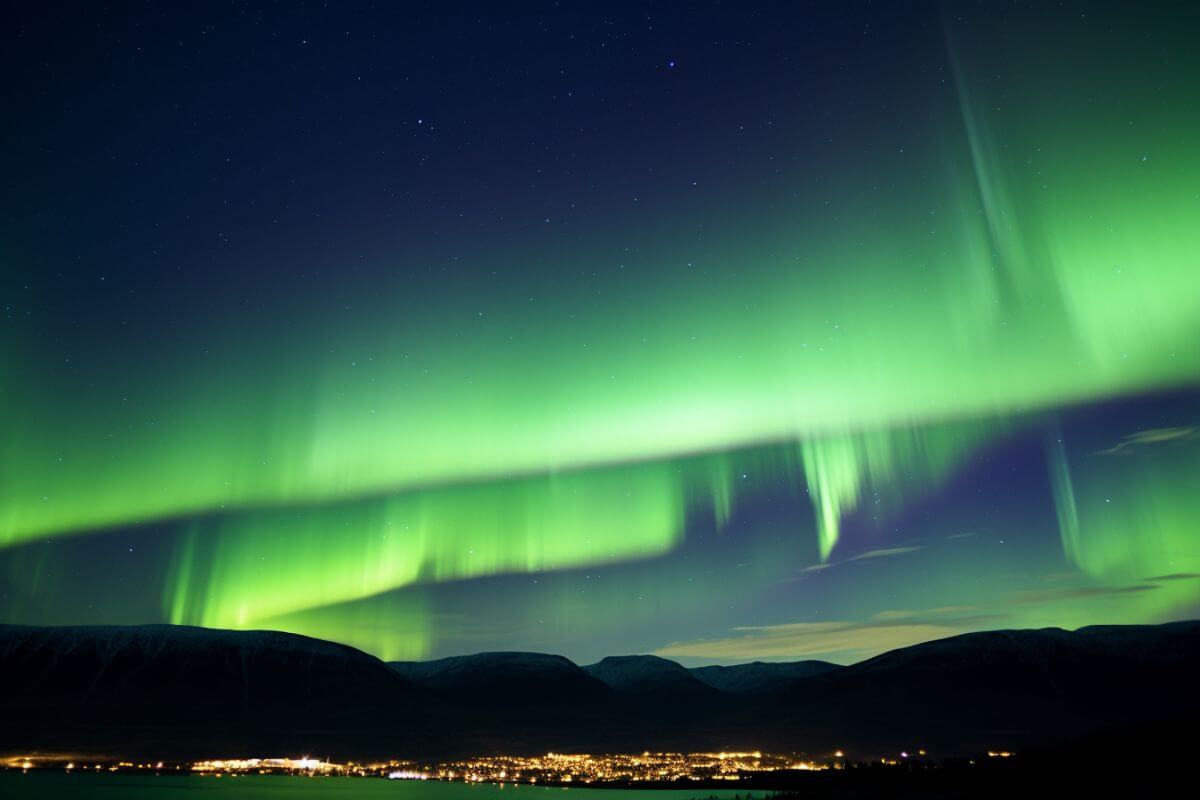
Missoula, a hidden gem for Northern Lights sightings, is celebrated for its trout fishing and vast wilderness that create an ideal backdrop for this natural spectacle. The city offers prime Northern Lights viewing during cloudless nights, taking advantage of the untouched wilderness for unobstructed views free from light pollution.
Beyond the Northern Lights, Missoula boasts diverse attractions, including outdoor activities like hiking, mountain biking, and white-water rafting. The city’s vibrant culture is also a draw, with breweries, historical museums, a lively food scene, and summer water parks adding to its allure.
Whether you’re an outdoor enthusiast or a culture aficionado, Missoula has something for everyone. With its stunning natural beauty and diverse range of activities, Missoula is a destination not to be missed.
3. Cascade County
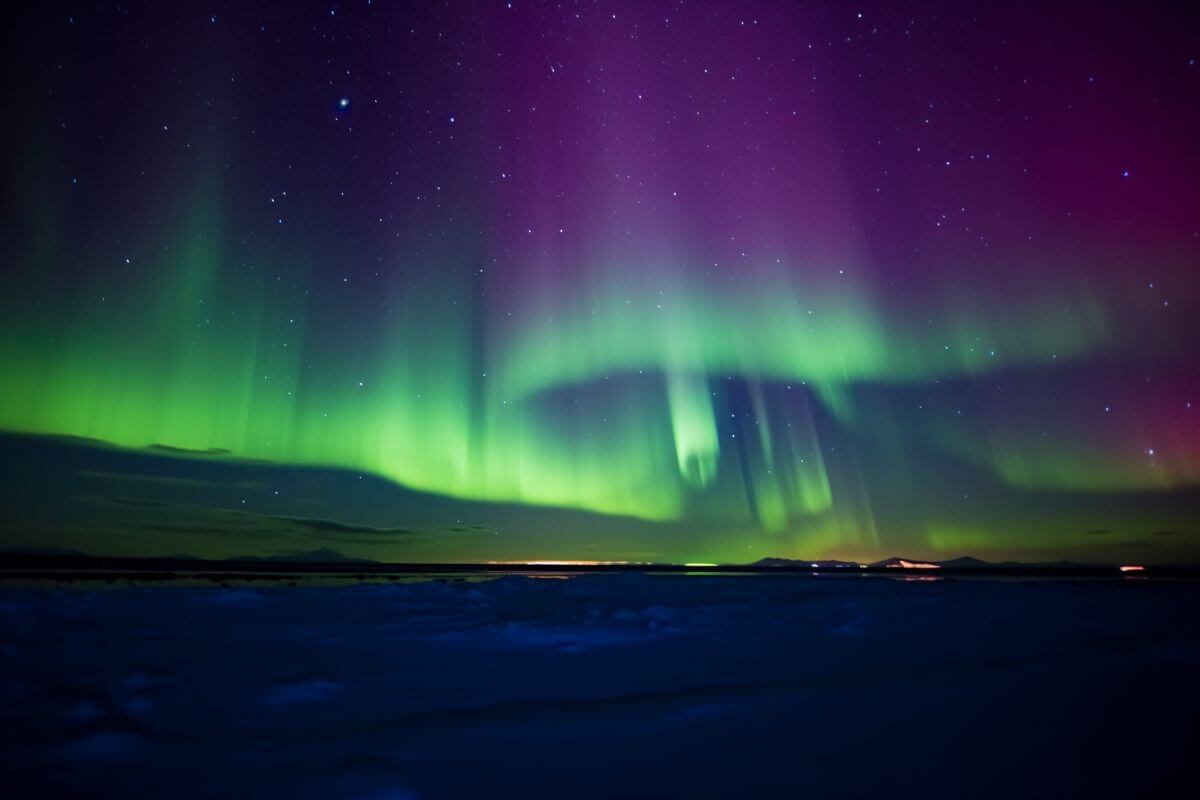
Let’s take a detour from the usual suspects and head to Cascade County, a central Montana region that offers more than meets the eye. You might be surprised to learn that this area, near the enchanting waterfalls of the Missouri River, is an unexpected yet remarkable spot for Northern Lights viewing.
Positioned near Missouri River waterfalls, it serves as an ideal base to escape the artificial lights of the city. Towns like Cascade, Vaughn, and Belt, 15-20 miles (24-32 km) from Great Falls, offer exceptional Northern Lights viewing opportunities, especially between September and March.
But the lights aren’t the only thing to marvel at in Cascade County. Here’s what else you can expect:
- Scenic Wonders – Cascade County encompasses parts of the Lewis & Clark National Forest and the Rocky Mountains. The rugged landscape adds an extra touch of magic to your Northern Lights experience.
- Waterfall Marvels – Don’t miss the chance to visit Rainbow Falls, Black Eagle Falls, Crooked Falls, and the Great Falls of the Missouri. These natural wonders, coupled with the dancing lights above, create a surreal ambiance.
- Nearby Gems – Take a short drive to Giant Springs and Giant Springs State Park, where you can explore the largest freshwater spring in the U.S. and enjoy serene walks along the river.
- History and Culture – Immerse yourself in the stories of Lewis and Clark at the Lewis and Clark Interpretive Center or explore the Great Falls Historic District, a treasure trove of architectural wonders.
- Art and Heritage – Dive into the world of renowned Western artist C.M. Russell at the C.M. Russell Museum. The museum houses an impressive collection of his art, giving you a glimpse into the area’s rich heritage.
The combination of natural wonders, historical sites, and, of course, the dancing lights above, promises an experience you won’t soon forget.
4. Seeley-Swan Valley
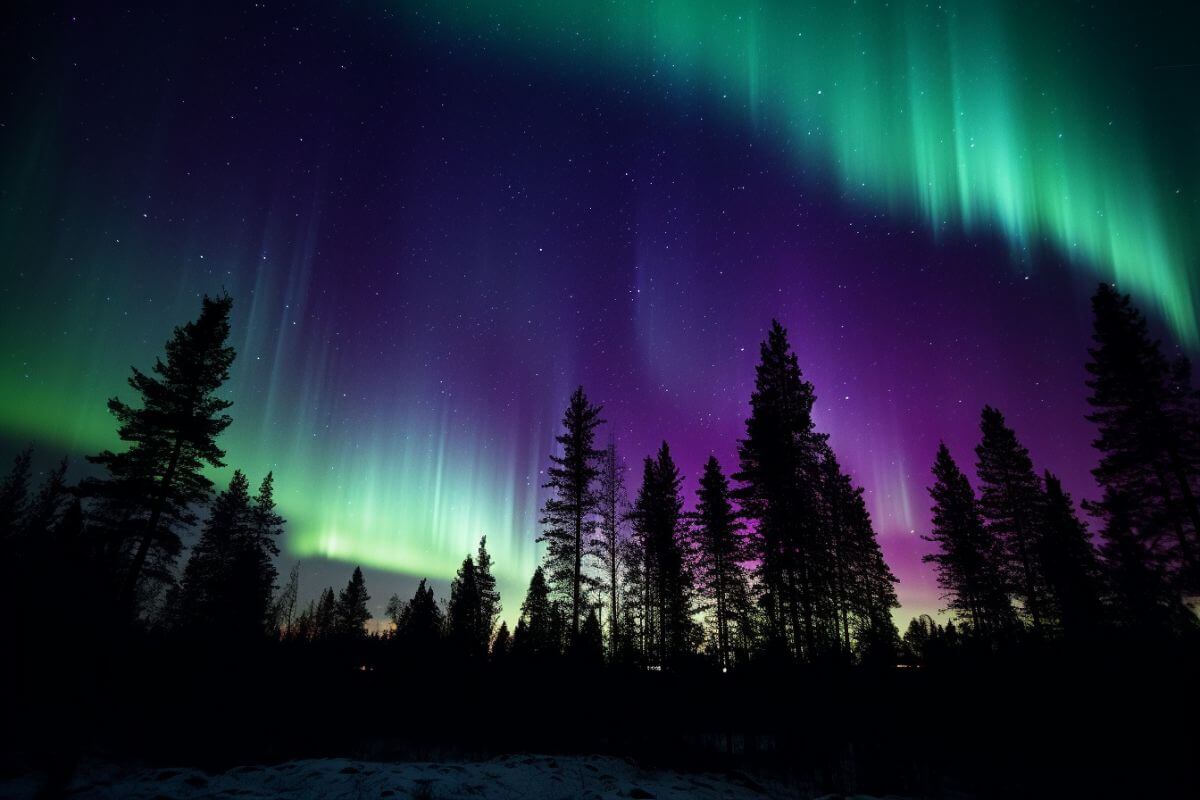
Northwestern Montana is a top destination for stargazing, with numerous campgrounds like the Seeley Lake Campground and wilderness areas perfect for observing the Northern Lights.
The Seeley-Swan Valley is a prime location with pristine natural lakes, offering unobstructed views of the night sky, ideal for Northern Lights viewing.
Its Swan Valley and Seeley Valley are renowned for their picturesque landscapes. The optimal timing for Northern Lights sightings is late fall through early spring, especially around an hour before and after midnight, with clear skies enhancing the viewing experience.
The valleys are nestled between the Swan Mountains to the east and the Mission Mountains to the west, attracting numerous visitors with their natural beauty and opportunities for camping, water sports, hiking, and horseback riding around the lakes. Happy stargazing!
5. Kalispell
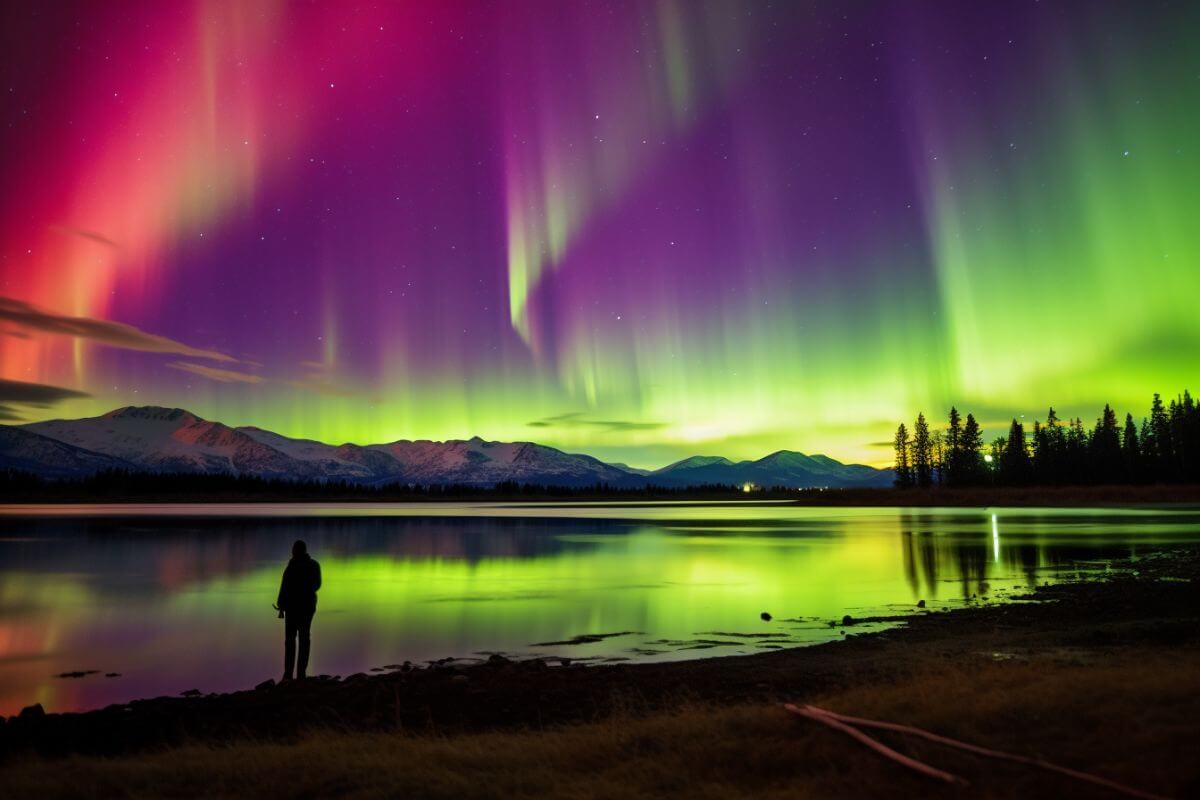
Lucky are those who catch a glimpse of the elusive Northern Lights in Kalispell, Flathead County. Although not a regular occurrence, past displays have left fortunate observers in awe.
Positioned between Glacier National Park and Flathead Lake, Kalispell offers an escape from the city’s hustle and bustle, allowing nature enthusiasts to relish uninterrupted views of the northern lights.
Known as “the Soul of Montana,” Kalispell attracts outdoor enthusiasts and serves as a gateway to the wilderness. Visitors can explore iconic landmarks and immerse themselves in a unique local culture that blends Old West charm with vibrant restaurants and boutique stores.
Kalispell’s prime location and captivating offerings make it a must-see destination for those seeking an authentic Montana experience.
6. Whitefish Lake State Park
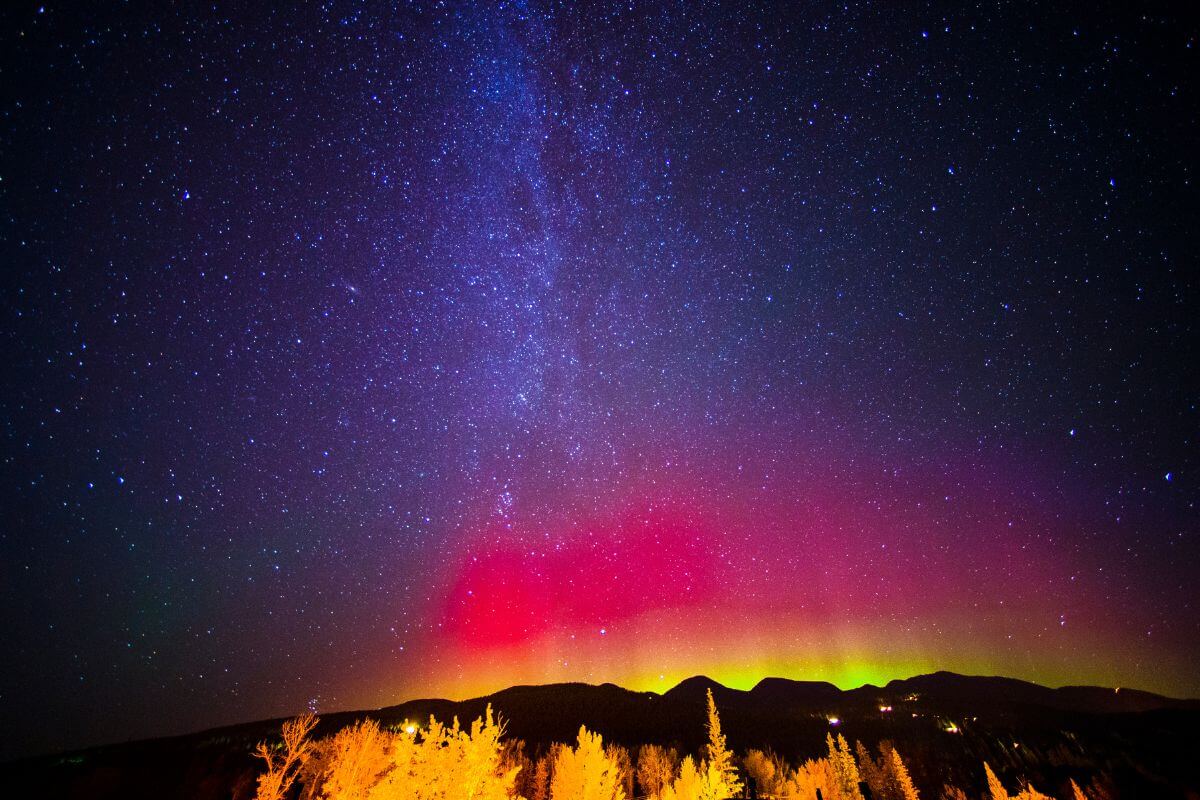
If you’re seeking a front-row seat to the celestial ballet of the Northern Lights, Whitefish Lake State Park should be high on your list. Situated in Flathead County, this expansive wilderness area is not only a gateway to Glacier National Park but also a prime location for Aurora Borealis viewing.
Why Whitefish Lake is a prime spot for Aurora Borealis gazing:
- The lake’s clear waters act as a mirror, reflecting the dancing lights above, creating an ethereal experience.
- Its location in Flathead County, alongside the vibrant towns of Kalispell and Columbia Falls, makes it a convenient and picturesque destination.
- Offering a range of water activities, from boating to skiing, it’s a versatile spot to enjoy the lights and the lake.
Why Whitefish Lake is rich in history and modern amenities:
- This isn’t just any lake; it’s the legacy of an ice-age glacier, making it a unique and storied place to witness the Northern Lights.
- The park isn’t just a patch of grass; it offers a small beach and multiple camping sites, providing you with optimal vantage points to experience the captivating Montana Northern Lights.
So, if you’re looking to pair your Northern Lights quest with a day of lakeside fun or a night under the stars, Whitefish Lake State Park is your ticket to a multi-sensory experience.
7. The Sleeping Giant near Helena
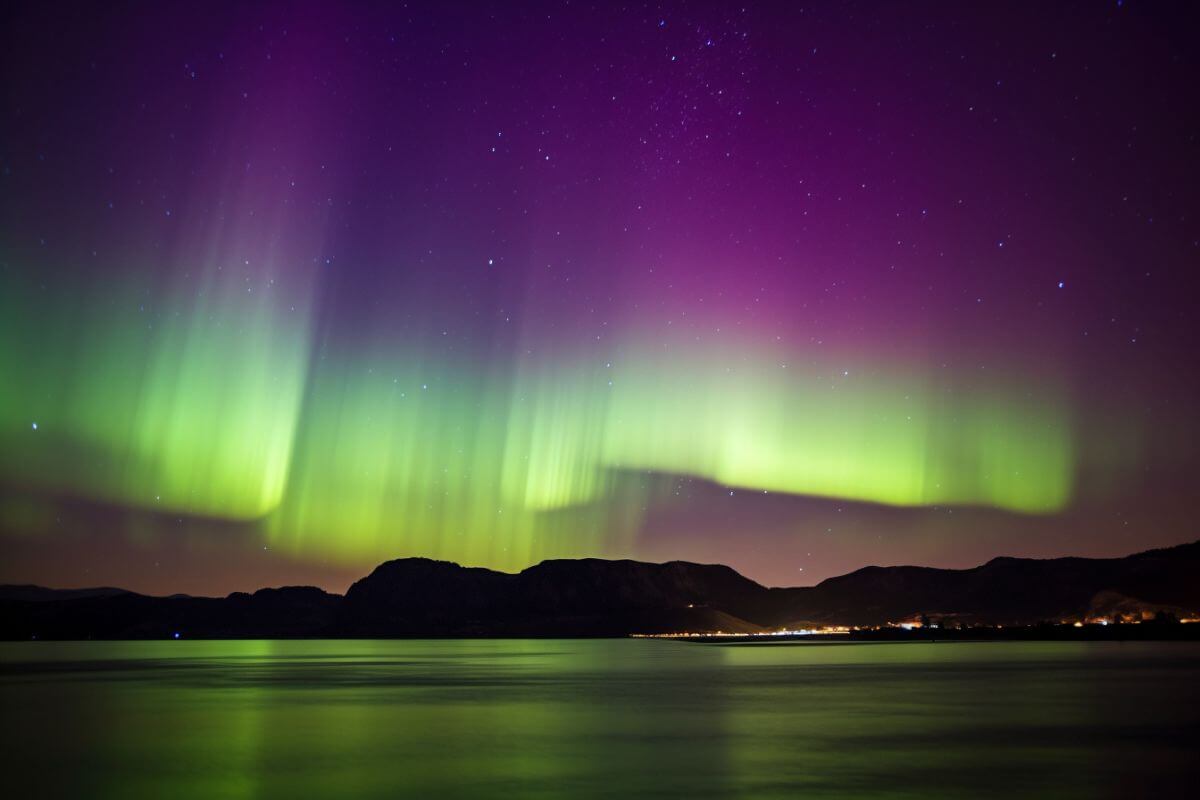
I just had to share with you my latest discovery: the breathtaking Sleeping Giant Mountain, located just 30 miles (48 km) north of Montana’s capital, Helena. This spot provides the perfect vantage point for witnessing the captivating Northern Lights.
With elevations reaching nearly 9,000 feet, this mountain is situated within a Wilderness Study Area, offering an enhanced sense of remoteness and seclusion.
The vast 7,000-acre wilderness park is devoid of roads, intensifying the expansive dark skies and amplifying the captivating allure of these bright dancing lights.
The absence of urbanization only heightens the mesmerizing effect of the auroras, creating an immersive experience under the open, starry expanse. Trust me, you don’t want to miss out on this unforgettable natural spectacle.
8. Bozeman
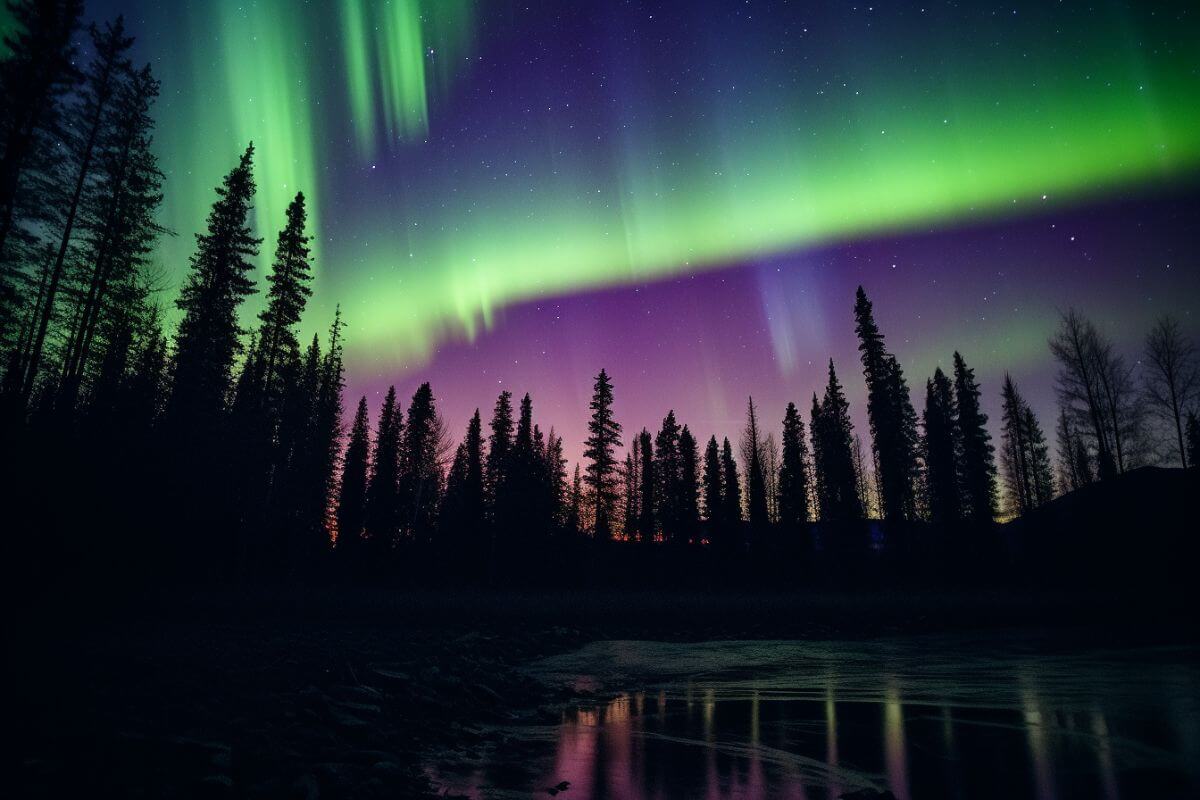
Bozeman isn’t just a hip, developed town; it’s a gateway to some of Montana’s most renowned areas for adventure and exploration. And when it comes to the Northern Lights, this mountain haven offers more than just a cozy spot to set up your camera.
Why Bozeman? It’s all about balance. While you’re still within reach of modern amenities and civilization, you’re also in prime territory to catch a glimpse of the northern lights.
Here are a couple of reported hotspots for your Northern Lights quest in and around Bozeman:
- Bear Canyon – Just a short drive south of Bozeman, this secluded canyon offers a serene setting away from the city’s glow.
- Canyon Ferry Lake – Positioned about an hour west of town along I-90 and US-287 N toward Townsend, this lake is a favored spot for both anglers and Aurora Borealis enthusiasts.
- Clyde Park – Located roughly 45 minutes east of Bozeman on I-90, this little town provides a clear view of the night sky with minimal light pollution.
The perk of being close to a city? You’re not as exposed to the biting cold of the surrounding terrain, making your Northern Lights experience a touch more comfortable.
What sets Bozeman apart from other towns is its minimal bright lights. This creates ideal conditions for a good view of the Northern Lights, allowing their vibrant hues to truly steal the show.
Whether you choose the rugged beauty of Bear Canyon or the tranquil shores of Canyon Ferry Lake, the Northern Lights will be the celestial cherry on top of your Montana experience.
9. Big Sky
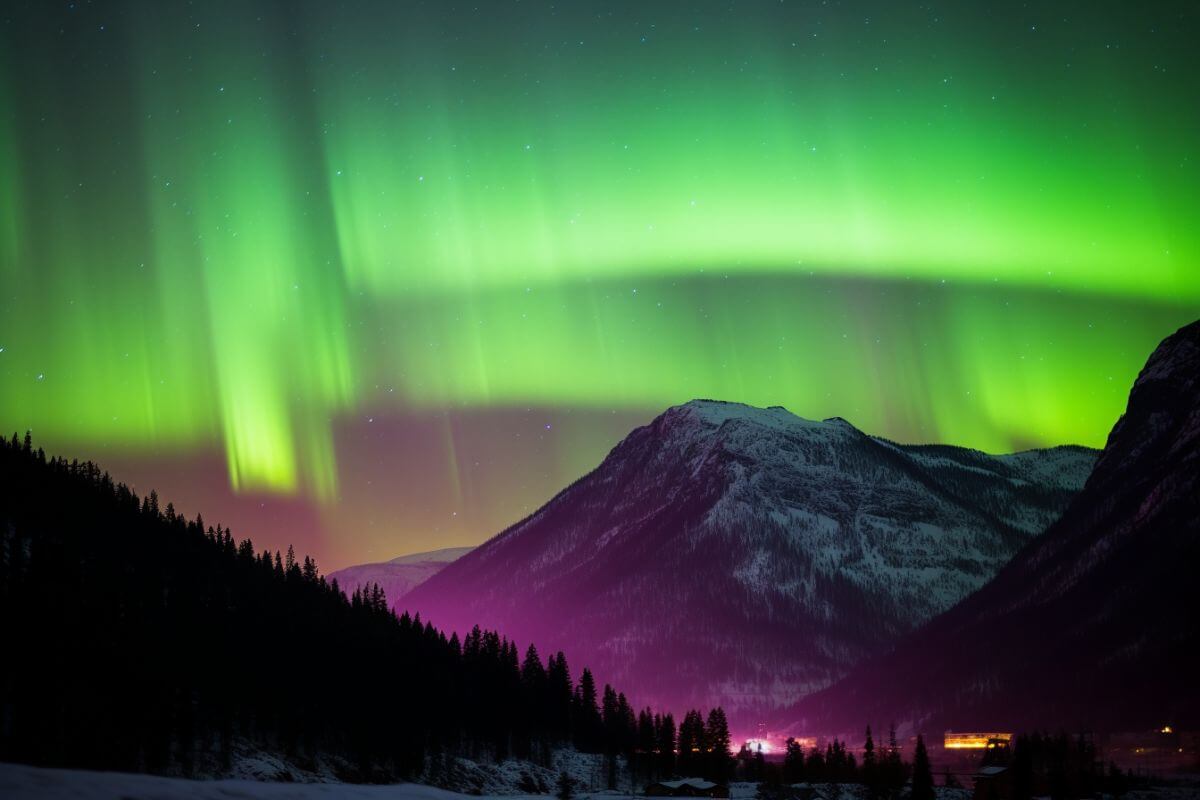
When it comes to the ultimate Northern Lights experience in Montana, Big Sky is the key destination. Accessible via Highway 191, this spot is just 45 miles (72.42 km) south of Bozeman, making it a promising location for Northern Lights observation.
Venturing deeper into Montana means expansive, darker skies, creating an ideal setting for witnessing the Northern Lights in their full glory. Careful planning and readiness are vital for such excursions, but the rewards of experiencing this celestial spectacle outweigh the preparation.
As the Northern Lights are sporadic, planning a trip to the Big Sky region involves considering the K-Index. This index tracks variations in the Earth’s geomagnetic fields on a scale of 0 to 9. A measurement of 7 or higher is typically necessary for a proper Northern Lights display.
Understanding and monitoring the K-Index for a few days before the trip is advisable for optimal chances of witnessing this phenomenon. So, when seeking the best spot for the Northern Lights in Montana, look no further than Big Sky for an unforgettable experience.
10. Makoshika State Park
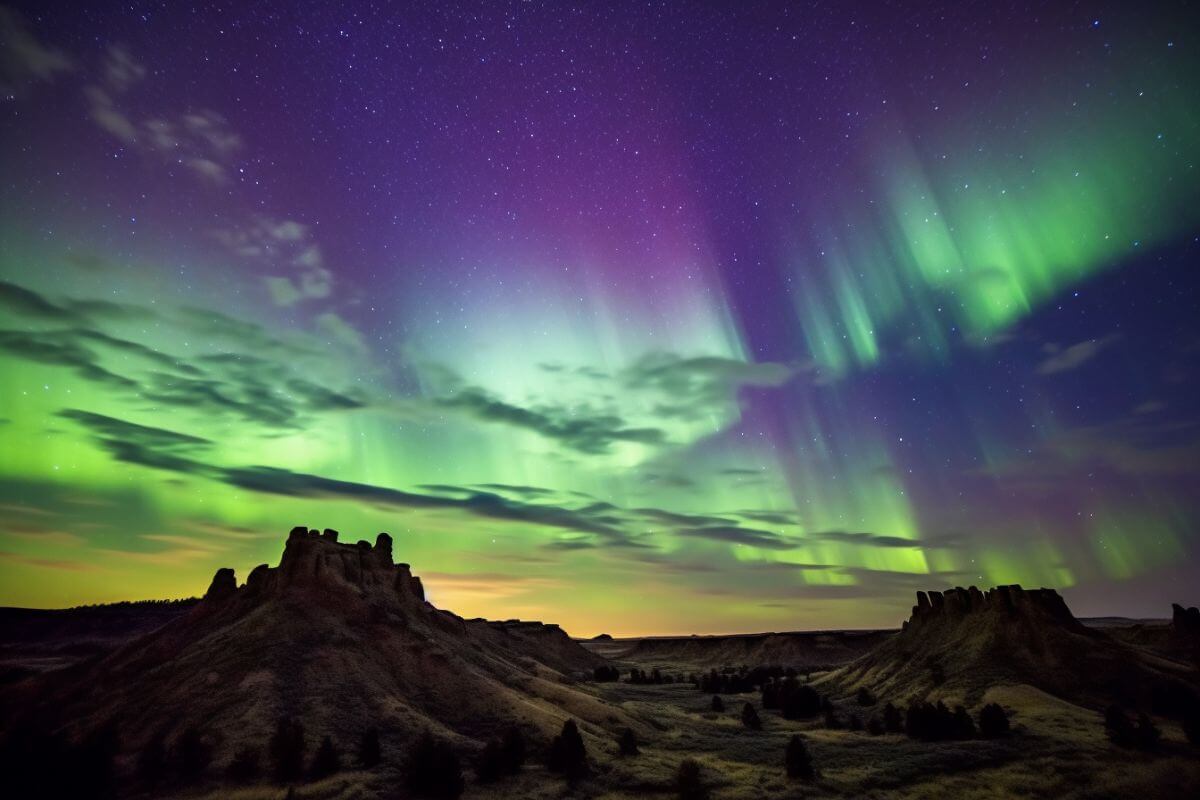
One of the best places to see the Northern Lights is Missouri Headwaters State Park. It’s just a short 30-minute drive from Bozeman, making it a perfect destination when the K-Index is high. The park’s proximity to Bozeman makes it easily accessible when the conditions are favorable for seeing the lights.
To get to the park, take the westbound route on I-90 and use exit 283. Follow the signs leading to Frontage Road and continue until you reach Missouri Headwaters State Park. Once there, find a comfortable spot to settle in and wait for the sky to put on a show.
The park’s location and accessibility make it a top choice for witnessing the Northern Lights. When the K-Index indicates that the lights are likely to appear, make the short drive from Bozeman to Missouri Headwaters State Park for a memorable experience.
11. Missouri Headwaters State Park
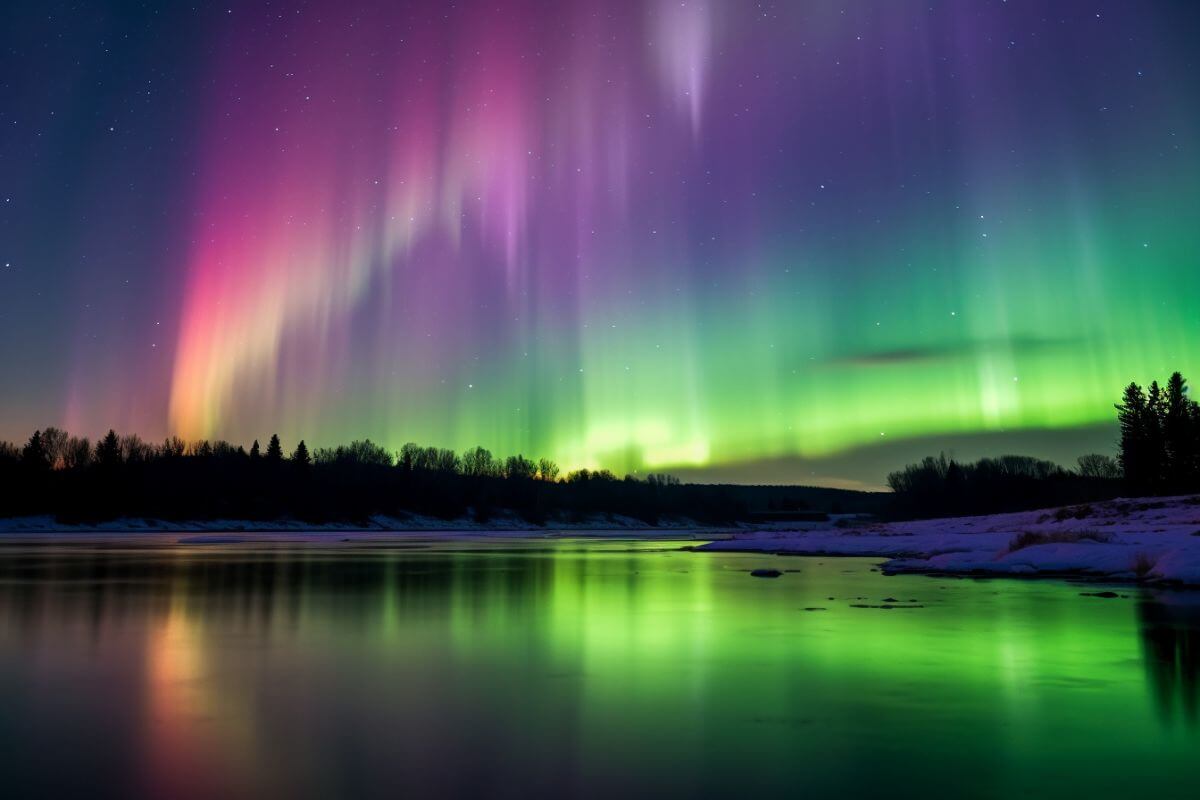
When the Northern Lights are putting on a show, you don’t want to be caught in traffic. That’s why I always keep Missouri Headwaters State Park on my radar.
The park is just a short 30-minute drive from Bozeman, it’s the perfect spot to set up camp and witness nature’s light display.
- How to Get There – Taking the westbound route on I-90 and using exit 283, you’ll want to follow the signs leading to Frontage Road. From there, it’s a straight shot until you reach the park. Trust me, the journey is as serene as the destination.
- Why It’s Worth the Trip – The park’s proximity to Bozeman makes it a perfect choice when the K-Index indicates a high likelihood of the lights. Additionally, the park offers stunning views of the Jefferson, Madison, and Gallatin rivers converging.
- My Tip – Pack hot cocoa and a cozy blanket for the best Northern Lights show experience — sometimes, snuggling up is the highlight. With Missouri Headwaters State Park nearby, you’re all set to enjoy the spectacle.
12. Yellowstone National Park
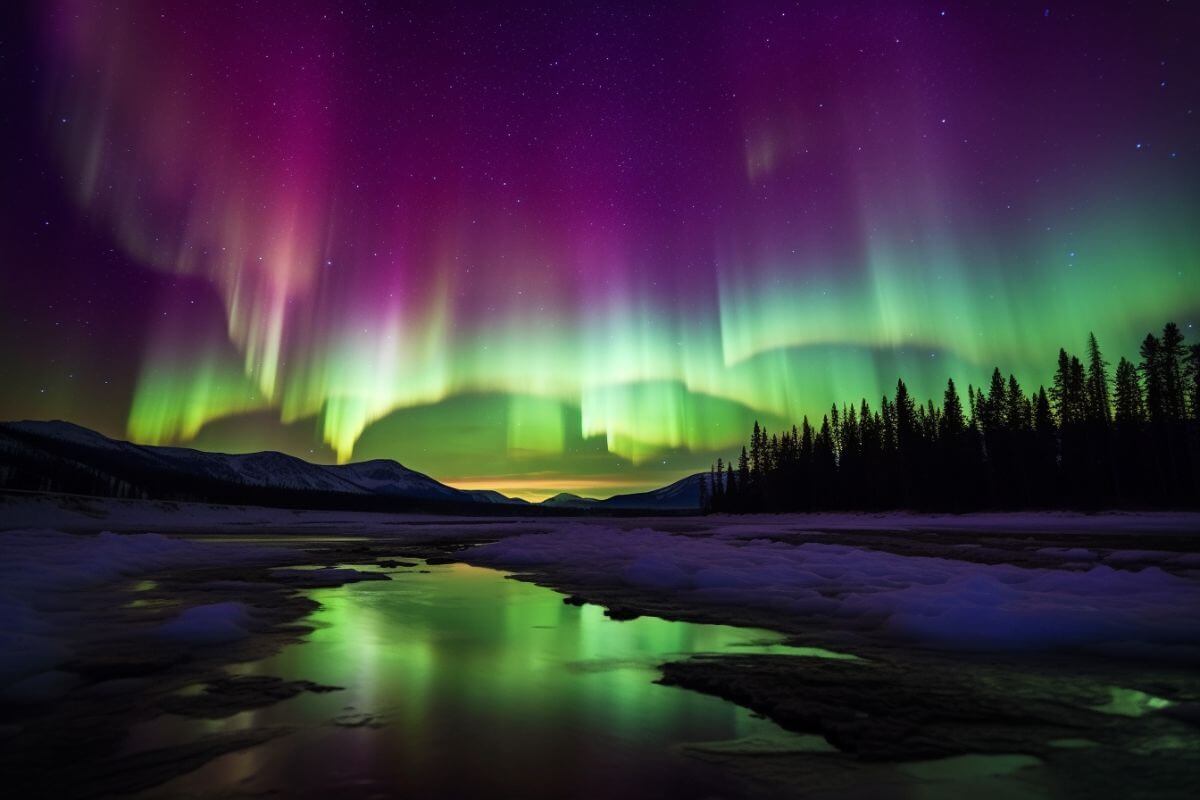
Yellowstone, the crown jewel of America’s national parks, isn’t just about geysers and bison. Occasionally, this vast wilderness serves up a celestial spectacle: the Northern Lights. While not as frequent as in other Montana parks, Yellowstone has its moments.
I still remember the buzz in the air roughly five years ago when the Upper Geyser Basin was transformed into a canvas of dancing lights. It wasn’t a display on the scale of Glacier or Waterton, but it was a rare treat and one that left visitors awestruck.
Why Yellowstone is worth a shot:
- Less Light Pollution – Compared to more built-up areas, Yellowstone’s remote location means you’ll have relatively low light pollution, making for some excellent vantage points.
- A Different Kind of Show – The Northern Lights here might not be as common or intense as in other parks, but the combination of geothermal features and the aurora can be truly unique.
Here’s the catch, the Northern Lights in Yellowstone are as unpredictable as Old Faithful. You could be in the right place at the right time, or you could be staring at a starry sky. It’s a roll of the cosmic dice.
So, if you find yourself in Yellowstone on a clear, moonless night, watch the sky. You just might get lucky and witness a celestial dance that adds yet another layer of magic to this already enchanting park.
Northern Lights in Montana: Best Times to See Them
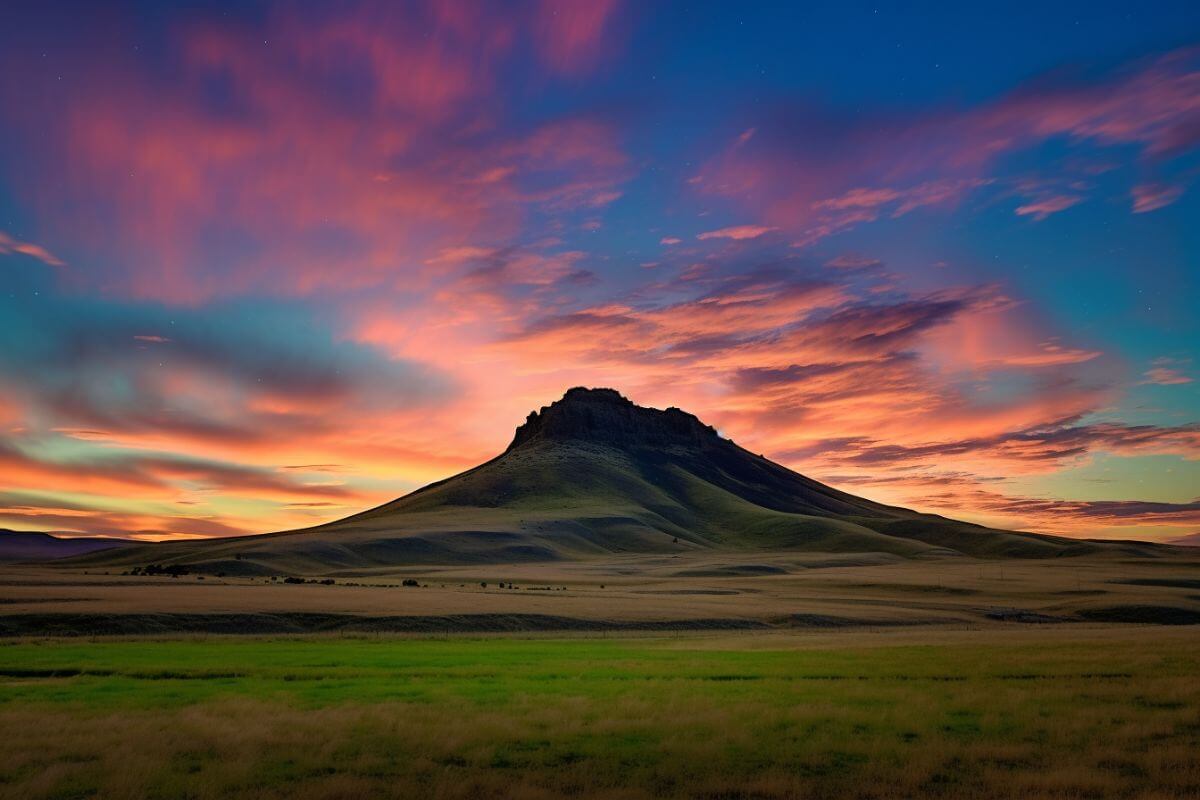
When it comes to observing Montana’s Northern Lights, pinpointing the perfect time is a bit of a conundrum. However, the Aurora Zone, known for its expertise in stargazing spectacles, offers guidance to aurora borealis enthusiasts.
So, when can you expect to catch a glimpse of this otherworldly light show? Here’s what the experts and my own experiences suggest:
- After Darkness Falls – Typically, the Northern Lights start making their grand entrance after Darkness Falls, which can be as early as 4 pm and as late as 6 pm, depending on the season.
- Prime Time – For the most successful sightings, you’ll want to keep your eyes peeled between 9:30 pm and 1 am. This window tends to be the sweet spot for witnessing the phenomenon in all its glory.
- Best Months – September to March are generally your best bets for catching the Northern Lights in Montana. Within this timeframe, January to March, with their longer nights, offer an even higher likelihood of a dazzling display.
Now, let’s talk about why January to March is the crème de la crème of Northern Lights viewing:
- Longer Nights – In these months, the nights stretch out, giving you more time to witness the mesmerizing dance of colors across the sky.
I remember one particularly clear night in February when I camped out near Glacier National Park. As the clock struck midnight, the sky transformed into a canvas of greens and purples, a sight I’ll cherish forever.
- Top Recommendation – If I had to pick a month to plan my Northern Lights adventure, it would be February. The nights are long, the air is crisp, and the chances of capturing a postcard-perfect moment are especially high.
So, make sure to time your Montana Northern Lights expedition during these prime months and hours. Mother Nature’s celestial show awaits; you don’t want to miss it.
Montana Northern Lights Final Thoughts
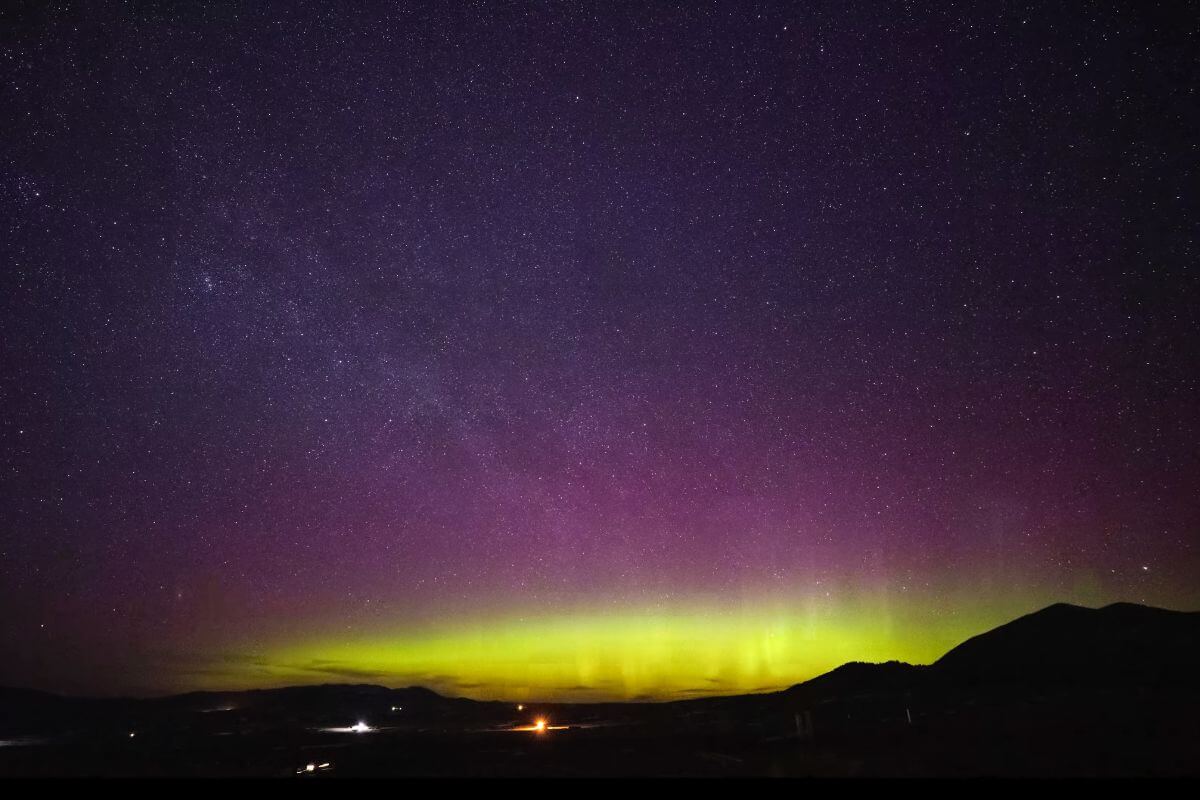
As I wrap up this exploration of Montana’s Northern Lights, witnessing the aurora borealis against the state’s untamed landscapes is truly enthralling. For optimal viewing, escape city lights and head north—Montana’s vast lands and small cities create ideal conditions.
Consider locations like Sleeping Giant or Missouri Headwaters State Park, where light pollution is minimal. The best chances are during clear nights between late fall and early spring.
The experience goes beyond the Northern Lights; it’s about the diverse opportunities Montana presents. Picture savoring Whitefish Lake State Park’s daytime vistas and being treated to a mesmerizing light show at night. Or immerse yourself in Kalispell’s cultural richness, knowing the Northern Lights may appear.
Plan a trip that promises both the aurora and an immersion into Big Sky Country’s heart. Whether you’re an adventurer or a culture enthusiast, Montana’s Northern Lights offer an unforgettable experience.
Montana Northern Lights FAQs
1. What Month Can You See the Northern Lights in Montana?
September through March stands out as the prime window for experiencing the Northern Lights in Montana.
These months, particularly January through March, offer extended periods of darkness, enhancing the prospects of witnessing the aurora borealis across the state’s skies.
As the nights grow longer during this period, the chances of catching this celestial phenomenon in its full glory increase significantly.
2. Can You See the Northern Lights From Bozeman?
Yes, Bozeman offers opportunities for viewing the Northern Lights. While it’s a developed town, its proximity to less developed regions makes it possible to catch glimpses of the aurora borealis.
Escaping the city lights and heading toward locations like Bear Canyon, Canyon Ferry Lake, or Clyde Park, situated within a short drive from Bozeman, increases the chances of witnessing this natural wonder.
3. Can Northern Lights Be Seen in Yellowstone?
Yes, although not as frequently as in some other locations, the Northern Lights can occasionally be seen in Yellowstone National Park.
The park’s relatively low light pollution provides opportunities for viewing the aurora borealis, and there have been instances of impressive displays, such as over the Upper Geyser Basin.
4. How Often Does Montana See Northern Lights?
Montana experiences the Northern Lights sporadically throughout the year. The frequency of sightings varies due to several factors like solar activity, weather conditions, and geographical locations.
While some regions in Montana might witness the aurora borealis more often, it’s generally an unpredictable natural phenomenon, making regular sightings uncommon.
Like this article? Check out more interesting stories from Montana:

